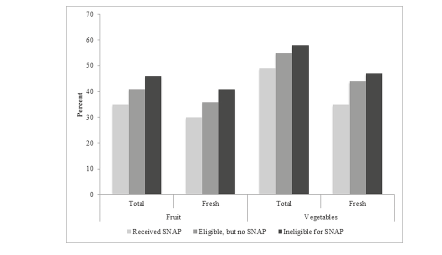SNAP eligibility, cooking frequency and fruit and vegetable consumption in the U.S.
In response to persistently high rates of obesity and associated dietrelated diseases, particularly among low-income populations, the education component of the Supplemental Nutrition Assistance Program (called SNAP-Ed) has recently shifted its focus from reducing hunger and food insecurity toward obesity prevention and nutrition.
SNAP-Ed, SNAP’s obesity prevention and nutrition education initiative, aims to help participants make healthy food choices within their limited budget, including increasing fresh fruit and vegetable consumption1. Encouraging home cooking is a key strategy for achieving this goal, and in addition to other program activities, SNAP-Ed catalogues budget friendly recipes targeted to participants on their website2. Evidence regarding the relationship between SNAP participation and diet quality are mixed; some evidence indicates that SNAP participation improves diet quality3, and increases fruit and vegetable consumption3 whereas other studies show the opposite4. In this study we examined patterns of fruit and vegetable consumption among U.S. adults by SNAP status and cooking frequency.
We used data from the consumer behavior module of the National Health and Nutrition Examination Survey (NHANES). We used data from 2007-2010, and our sample included adults aged 20 and older who were not pregnant or diabetic at time of data collection (N=9,560).
Using 24-hour dietary recall data, we measured fruit and vegetable consumption defined two ways: 1) total fruit/vegetables including raw, fresh, frozen, canned, dried and pickled, 2) fresh fruit/vegetables including only raw or cooked from raw. White potatoes and sauces (e.g. tomato sauce) were excluded from the vegetable category. Cooking frequency was measured based on the number of times the respondent or someone in the household cooked dinner in the previous 7 days. We categorized cooking frequency as low (zero to one times, N=802), medium (two to five times, N=3,704) and high (six to seven times, N=5,063). SNAP status was defined three ways based on self-reported SNAP participation and self-reported household income:
1) receiving SNAP;
2) income-eligible but not receiving SNAP; and
3) incomeineligible for SNAP. We included measures of gender, race/ethnicity, age, education, marital status, employment status, country of birth, household size and household food security.
We used multivariate models adjusting for the above covariates to estimate the association between SNAP eligibility, cooking frequency and fruit and vegetable consumption using an interaction term between cooking frequency and SNAP eligibility. All significance tests were considered at p<0.05.
SNAP participants cook more but consume less fruit and vegetables than non-participants
62% of SNAP participants cooked dinner six-seven times/week compared with 46% of ineligible non-participants. However, SNAP participants were least likely to consume any fruit or vegetables compared to those not participating in the program, regardless of cooking frequency. Frequent cooking (>6 times/week) was associated with increased volume of consumption of fresh vegetables only among those ineligible for SNAP.
Fewer SNAP participants consumed fruit and vegetables, both total and fresh, compared to both income eligible and ineligible nonparticipants (figure 1). Compared to low cooking frequency, high cooking frequency was associated with consumption of a higher volume of vegetables among SNAP participants and income-ineligible non-participants. Among income-ineligible non-participants only, high cooking frequency was associated with greater consumption of fresh vegetables compared to individuals living in low and medium cooking frequency households.
Figure 1: Percent of adults who consume any fruit and vegetables by SNAP participation status, NHANES 2007-2010.

Price, perishability and ease of preparation are important considerations for incentivizing fruit and vegetable consumption
We find that fruit and vegetable consumption is low overall, particularly among SNAP participants. Price, perishability, and ease of preparation of ingredients are particularly important to those eligible for SNAP and should be taken into consideration by policies and programs designed to encourage healthy eating. SNAP should consider exploring policy changes to incentivize healthy home cooking among participants. For example, SNAP benefits can currently be used at farmer’s markets and, in some states may be doubled when used for fresh, locally grown fruit and vegetables. Applying these incentives to non-fresh alternatives at supermarkets (e.g., frozen) may help to increase produce use in household cooking. The SNAP benefit structure could be modified so that the Thrifty Food Plan includes alternative fruit and vegetables requiring less time and preparation. SNAP-Ed could expand to teach comprehensive cooking skills education including how to navigate the grocery store, budgeting, meal planning, safe storage, and quick and easy cooking techniques. Efforts to shift the balance from consumption of foods away from home to more home cooked meals and increased produce consumption should consider the contexts and constraints in which food choices take place.
References
- Supplemetal Nutrition Assistance Program Education Guidance. 2014. (Accessed June 2, 2014, at http://snap.nal.usda.gov/snap/Guidance/FinalFY2015SNAP-EdGuidance.pdf.)
- What’s Cooking? USDA Mixing Bowl. (Accessed October 8, 2014, at http://www.whatscooking.fns.usda.gov/.)
- Gregory C, Ver Ploeg M, Andrews M, Coleman-Jensen A. Supplemental Nutrition Assistance Program (SNAP) Participation Leads to Modest Changes in Diet Quality. Economic Research Report 2013;147.
- Leung CW, Ding EL, Catalano PJ, Villamor E, Rimm EB, Willett WC. Dietary intake and dietary quality of low-income adults in the Supplemental Nutrition Assistance Program. The American journal of clinical nutrition 2012;96:977-88.
